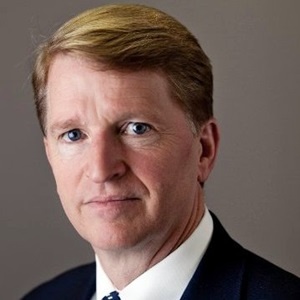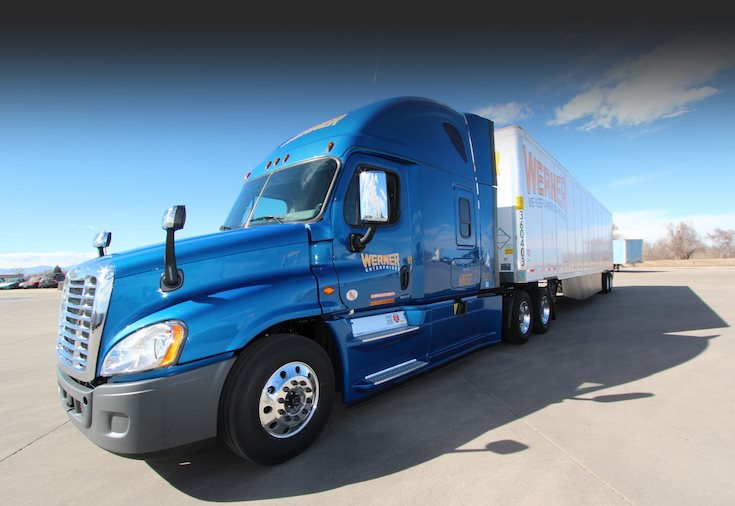CEOs and boards usually get nervous about CIO candidates who have moved around a lot between jobs and companies. They don't like to see "jumpy" resumes. But Nathan Johnson's diverse industry experience, gained from multiple jobs he’d held in virtually all modes of transportation and logistics, was just the sort of background that Werner Enterprises was looking for.
Heller Search: What is Werner Enterprises’ business?
Nathan Johnson: Werner Enterprises is a transportation and logistics company founded in 1956. Werner is among the five largest truckload carriers in the United States, with $2 billion in revenue and more than 11,500 associates and independent contractors. Werner’s global headquarters is in Omaha, Nebraska, and we have offices across the U.S., Canada, Mexico, China and Australia.
Were you actively looking for a new CIO role?
I was actively looking for a new leadership role while consulting with a few different organizations. Previously, I served as SVP/CIO for a private-equity backed logistics services company where I led a four-year transformation and integration initiative, bringing together multiple technology teams from several acquisitions, and establishing a shared-services technology organization.
What type of consulting were you doing before joining Werner?
 I was doing high level strategic consulting for a technology managed services provider, helping them evaluate operating processes and organizational structure as part of a strategic shift in their offerings. I was also providing a ‘customer perspective’ from my experience as a managed service purchaser.
I was doing high level strategic consulting for a technology managed services provider, helping them evaluate operating processes and organizational structure as part of a strategic shift in their offerings. I was also providing a ‘customer perspective’ from my experience as a managed service purchaser.
Why did you decide to leave consulting and find a new CIO role?
I enjoy the variety, challenges and the learning that come with consulting, but in the end, I missed the opportunity to define business needs, establish strategy, lead initiatives and be accountable for the outcomes.
What else were you looking for in a CIO position?
I like being challenged and leading change, so I was searching for an opportunity that would leverage my supply chain and technology background in an organization that was committed to investing in technology to drive business transformation.
Key leaders in the transportation and logistics industry are embracing the latest social, mobile, IoT and cloud technologies to improve safety and productivity. They’re exploring alternative fuels and autonomous vehicle capabilities to transform the industry. I was looking to partner with this type of leadership team.
How did you hear about the CIO opportunity at Werner?
I heard about this opportunity through pure networking, which I find is usually the case. A recruiter working on the search contacted someone in my network, who then passed along my name. A couple phone calls later and I was speaking with the CEO. I am a big believer in the importance of keeping your relationships and network active, and investing in it even if you aren’t looking for a job. I also believe you should ‘pay it forward’ to assist others who are in a job search.
What piqued your interest?
Werner’s business model and strategy fit my background and target profile. I have had broad logistics and technology experience with several supply chain organizations during my career, which fit well with Werner’s history of growing from a domestic carrier into a global logistics provider with many interesting challenges and opportunities.
As I learned more about the company and culture, I became increasingly interested. The executive team members were highly regarded in the industry and they all had proven records of accomplishment and came highly recommended by several people in my network. The founder and executive chairman has been a leader and innovator across our company’s 60-plus year history, and our CEO is focused on improving upon an already strong business model, including investments in technology to drive innovation.
What specifically did you hear about the culture at Werner that resonated with you?
We’re customer-, safety- and service-focused, and at the core of that equation are our professional drivers and logistics professionals. Werner has invested heavily in upgrading our truck and trailer fleet, and our terminal facilities, to attract and retain the best drivers in the industry. Accelerating the adoption of technology to this talent pool enables us to operate safely and deliver exceptional services.
We also have an incredible track record and tradition at Werner. There have been just three CEOs here in the last 60 years, and our current CEO, Derek Leathers, led the formation and growth of our logistics business before taking over as president and COO several years ago. Our founder, C.L. Werner, who started the company at age 19 with one truck, is still actively involved and serves as the executive chairman. To have a strong CEO and the company founder still actively leading and contributing to the company meant a lot to me.
What was it about your professional background that was attractive to Werner?
I believe they liked that my background spans a variety of transportation and logistics industry segments, and I’ve led technology-based transformations in multiple organizations. My experience covers more than just trucking. I’ve worked in different environments as a shipper, carrier and service provider spanning several transportation modes: core trucking, non-asset logistics, freight management, intermodal operations, brokerage and global maritime.
While some people might view the number of career moves I’ve made as a liability, I believe my diverse background brings value and I promoted that in my discussions.
About our Recruiting Process |
How did you counter the ‘job-hopper’ fatal objection?
I truly believe the value of my experience outweighs the potential negative of career changes, but you need to present the facts and metrics of your career progression to support that position. You have to incorporate the value of your experience into your elevator pitch. I started with the fact that I’d spent the first 13 years of my career at just two companies, but I worked on over a dozen projects driving change and business transformation during that time. My first job after college was with a company that went through three LBO’s and an IPO in eight years. That’s where I gained a core competency in technology and dynamic change management. I followed that with five years at Andersen Consulting where I learned the value of process and methodology. These experiences gave me a foundation I’ve leveraged throughout my career.
Also, remember that you have to read your audience. Own your career and the reasons for your changes - don’t try to sugar coat it. Be proud, but be factual, and focus on the values you gained through your career changes. And don’t forget to mention what drove your career transitions, openly and honestly.
Get your elevator pitch on paper and review it with your peers, recruiters and have a good friend or your spouse review it and give you feedback.
Was there anything particularly unexpected or memorable about the interview process at Werner?
Several meetings were joint interview sessions with small groups from Werner, which I found to be very productive, and I think the executives did as well. They were much more intense but also less formal than a one-on-one interview. Several of these were long lunches, which became more like discussions rather than interviews. I was able to learn a lot more about the company and the position, and they learned about my background and approach to work.
How did you prepare to start your new role?
I’ve always crafted a 90-day plan for my new roles, but in this case, I took it a step further. Leveraging the knowledge from the joint interview discussions, and even before I received the offer, I drafted an assessment of the situation based on what I had heard and observed. It eventually became an eight-page PowerPoint summarizing the pain points, my observations and recapped areas of opportunity, concerns and challenges.
Just like my career elevator pitch, once I had this on paper, I could validate it and use it to form the basis of my 90-day plan. It became a discussion document that I continued to tweak and refine for the first several months after starting.
Who do you report to?
I report to Derek Leathers, the president and CEO, but the entire leadership team is vested and interested in what we are doing in technology. We quickly established an executive steering committee that meets every two weeks to review in-flight and proposed enterprise projects. We also have several steering committees driving departmental initiatives, and we are forming user groups to help ‘mine’ for user enhancements and improvements that drive productivity across our business process. The company has really embraced transparency and that has helped accelerate our progress.
From day one, what are some of the concrete steps you took to build relationships across the enterprise?
The assessment helped me begin establishing relationships. As I met people, I used the knowledge gained from that assessment and updated it to help demonstrated my interest, empathy and motivation to learn about what it is we do as a business. We’ve focused on their needs and worked hard to identify the deficiencies or gaps in our technology services.
Within the IT services group, we’ve held ‘get acquainted’ sessions with the entire team – usually over breakfast or lunch – and I tried to have no more than two people from any one group present. I wanted cross pollination during these meetings to foster a collaborative environment.
What have you been working during your first year?
We took a quick survey of the technology stack and information security position, began building out the application portfolio and reviewed our project backlog and the alignment to business goals. The project backlog became our top focus and we’ve established the proper governance to help ensure that the project portfolio is aligned. As the business owner for many of the infrastructure services, the ITS leadership team has launched several initiatives and shifted our staffing and planning from a supply-constrained process to a demand-driven process based on business value.
Have you made any changes to the structure of the IT organization?
We ran very decentralized - most projects didn’t have good staffing plans, schedules or clear business priorities. Our systems are highly integrated and, in many cases, we had cross-team resource conflicts that would impact project timelines and delivery. So, we established a new planning, PMO and analysis group, which functions as a competency center for these critical disciplines and creates consistency across the teams.
We’ve established a new senior financial analyst role in IT to ensure our expense and project cost management is in place and critical financial analysis and budget/forecast management is performed. Historically, we’ve battled resource constraints, but with improved visibility and clear executive sponsorship, we have better engagement and are building teams and staffing to meet demand.
We’ve also adopted a graduated approach to how we manage project prioritization. Enterprise projects are managed by an executive steering committee, and all other major projects have a sponsor that is an SVP or higher in the company and minor projects are governed at the departmental level. This has allowed us to drive project ownership and business benefit up the chain to the executives, while not clouding the key issues with smaller items.
How do you know when your IT organization is succeeding?
I have a couple favorite phrases that I regularly share with the team: ‘think big, start small, deliver quickly’ and ‘keep the end in mind’. As technology continues to evolve at break-neck speed, we all need to become more agile and adapt to innovation, which makes quality service even more critical. Our business focuses on safety and service, and our IT services are a critical element of that. When we have quality service, our technology leaders are able to invest time talking with our business partners about what we need to be doing next. When we have planned and are executing on the most important initiatives supporting our business priorities, and we can speak with confidence about the next story, epic, project phase or roadmap items, then I know we are doing the right things as an IT organization.
About Nathan Johnson
Nathan Johnson joined Werner Enterprises in July 2016 as senior vice president and chief information officer. With more than 30 years of experience, Johnson is a leading innovator of supply chain and information technologies. Prior to joining Werner, Johnson served as senior vice president and chief information officer for Ports America, served as chief information officer with several logistics companies and consulted with Fortune 500 companies.

Written by Steve Rovniak
Steve Rovniak served as Executive Director, Marketing and Media at Heller Search Associates from 2012 to 2023.



